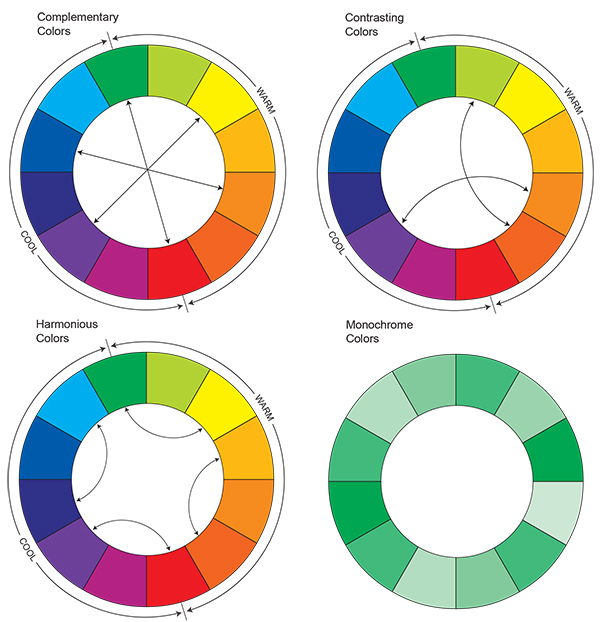Spin the Color Wheel
What colors work best together? Start by reviewing the principles of the standard color wheel, which organizes the color spectrum (representing the actual 16.7 million available color shades) into an easily usable format.
Once you know what you are looking for in color blends, you can review the PANTONE® color chart of a printer to see if it meets your business needs.

Essentially, the color wheel is divided into two halves, warm and cool shades. Warm colors, such as yellow and red, advance (or jump), which makes them effective for spotlighting items. Cool colors, such as violet and bluish green, recede (or fade) and are considered to be calm, which makes them a good choice for backgrounds. (Note that each color segment represents the entire range of shades within that hue. Green and red have both warm and cool shades within their hues.)
Complementary colors lie directly across from each other on the color wheel and tend to be lively, vibrant hues. Harmonious colors, also called analogous colors, are separated by one segment on the color wheel. Contrasting colors are separated by three segments on the color wheel.
When choosing the appropriate colors for your own palette, the trick is to let one color dominate and reserve its "partner" color for accents only. Using color combinations at full-saturation levels can have an overwhelming effect, so it's best to choose a tint or percentage of the true color, or tone down both colors.
Monochromatic colors, which are varying tints of a single hue (such as light green, true green, and dark green) allow you to broaden your choices within a single color selection.
Primary colors refer to red, blue and yellow and form a triangle with each other.
Secondary colors are located midway between the primary colors.
Once you've decided on your basic color scheme, zero in on specific colors from the industry's most recent color forecasts, from resources such as The Color Association of the United Status (CAUS), The Color Marketing Group, or PANTONE to ensure your choices are in line with upcoming color trends.
Articles connexes

Étude de cas Bell Law
Découvrez comment un grand cabinet d'avocats spécialisé dans le droit du travail a surmonté les obstacles liés au traitement et au partage des documents grâce aux solutions innovantes fournies par Xerox® Workflow Central.

Créer un environnement bureautique plus durable
Découvrez comment Xerox apporte aux entreprises des solutions d’impression plus écoresponsables et des stratégies durables. Solutions écoresponsables, recyclage, et bien plus encore.

Rendre le travail hybride efficace
Découvrez quelques-uns des meilleurs conseils de Xerox qui rendent le travail hybride efficace dans les petites et les moyennes entreprises.

3 éléments essentiels de la cybersécurité - Partie 1
Découvrez comment les technologies Xerox peuvent aider à sécuriser votre imprimante et vos données.

3 éléments essentiels de la cybersécurité - Partie 2
Découvrez comment les technologies Xerox peuvent aider à sécuriser votre imprimante et vos données.

Cet organisme de formation offre des méthodes d'apprentissage innovantes, rendant les contenus plus accessibles.
Le personnel de formation de CRC Formation utilise Xerox® Workflow Central pour fournir aux stagiaires de nouvelles méthodes d'apprentissage.





